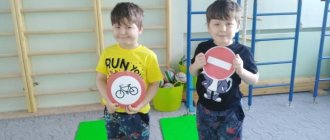Talking to children about behavior
Conversation with children on the topic “How well-mannered people act”
Goal: explain to children the rules of behavior in a team and the need to comply with them. Activate the appropriate vocabulary in speech.
Progress of the lesson.
The teacher tells the children:
“Mom with her son and daughter, your peers (can you imagine how old the children were?), got on the bus. There were no empty seats.
-Where do we sit? - the girl asked loudly.
- We will stand with you. “You are already big enough, and the playground is free, and no one will push you,” my mother noted.
Hearing this conversation, one of the passengers suggested: “Seat the children,” and made room for them. Mom didn’t even have time to say a word, but the guys had already sat down and, pleased with themselves, looked at their mother. She had a sad face.
- You are tired? Are you sick? - the son and daughter were alarmed.
- No, I didn’t get sick, but I was very, very upset. After all, now I have learned that my children cannot be called well-mannered people.
“Who did you find out from?” the daughter asked in bewilderment.
- I found out from you! - Mom explained and turned to the window.”
The teacher asks if the children liked the story. She clarifies from whom the mother learned that her children were not very well-mannered people, and how the children should have behaved so as not to upset their mother.
After listening to the children’s answers, the teacher summarizes them, then offers to repeat (in chorus and individually) the phrases with which it is customary to address a person when giving up his seat on public transport.
“Imagine,” the teacher continues the conversation, “that you and your grandmother got on the bus. And there is only one free seat on the bus. What should I do? And what do educated people do in this case?
And now you have made a transfer and are traveling by trolleybus. We saw two empty seats and sat down. And at this time a woman with a heavy bag stopped opposite. What will you do?
In conclusion, the teacher suggests making buses out of chairs and heading out of town, observing the necessary rules of behavior during the trip.
sundekor.ru
Memo “Rules of behavior at the table for older preschoolers”
- Sit up straight, don’t “fall apart”;
- Feet together, do not cross your legs;
- Don't shuffle your feet;
- Don't talk while eating;
- Don't twist or push;
- Eat and don’t get dirty, don’t spill food on the tablecloth;
- Don’t bite off big pieces – eat slowly;
- Eat with your mouth closed, do not slurp;
- Hold your spoon, fork and knife correctly;
- Don't crumble the bread, bite it over your plate;
- Bend over the spoon, do not bring it to your mouth;
- When you drink, raise the cup to your mouth;
- After eating, put the cutlery on the table;
- When you get up from the table, pull up your chair and thank the adults.
School table manners
Of course, school is not a kindergarten. Its main function, after all, is educational, and educational is only secondary. Children are at school only half the day, but at school children also eat. Meals for schoolchildren are provided in the school canteen. The children all eat together, and the time allotted for food is quite short - only 15-20 minutes. Therefore, compliance with the rules of behavior at the table is mandatory.
Rules of behavior in the school canteen
- Don't run. You must walk to and from the dining room at a normal pace so as not to become a victim or cause of painful injury;
- Wash your hands before eating;
- Don’t rush to take a seat, don’t push your comrades out of the way;
- Maintain the order;
- Walk calmly around the dining room, watch your step so as not to slip;
- Do not swing your arms if you are holding instruments in them;
- Do not talk while eating, eat with your mouth closed;
- Use cutlery correctly. Remember what is eaten with a spoon and what is eaten with a fork and knife;
- Use napkins;
- Don’t drop food on the floor, and if you drop it, pick it up;
- Don’t speak badly about the dishes – respect the work of the cooks;
- After eating, put away your dishes;
- Be polite and thank the cafeteria workers.
It is important to remember that children do not learn table manners from books or instructions, but rather learn from their parents. Do you want your child to have an idea about proper nutrition and its organization? So, pay attention to how the table is organized in your family? Cover the table with a tablecloth, no need to wait for special occasions. Use beautiful cutlery, be nice to each other at the table. Get together more often - it greatly strengthens the family and creates an atmosphere of trust. Let these little things become the norm in your home. Add your own special family rituals that your now-adult children will proudly bring into their future families as heirlooms that keep you all together.







